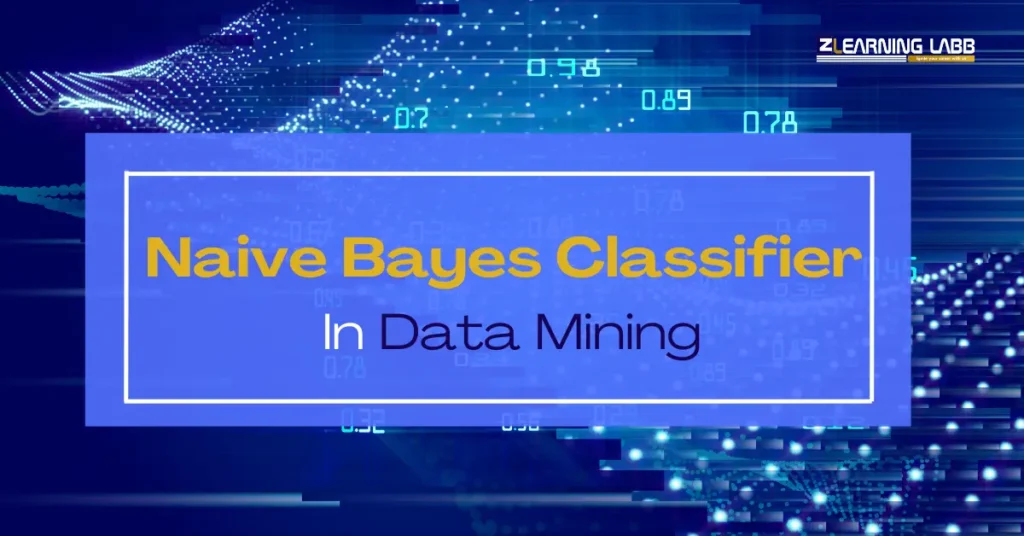Naive Bayes Classifier In Data Mining: This article explores the Naive Bayes Classifier, a prominent probabilistic machine learning algorithm widely employed in data mining. We will explore its foundational principles, including Bayes’ theorem and the assumption of feature independence.
What is Naive Bayes Classifier?
The Naive Bayes Classifier in data mining stands as a prominent probabilistic machine learning algorithm, founded on Bayes’ theorem. Its simplicity and efficiency make it a favored choice for various classification tasks, particularly in domains like text classification, spam filtering, and sentiment analysis. At its core, Naive Bayes operates by predicting the probability of a class given a set of features.
How Naive Bayes Classifier Works
The fundamental principle of the Naive Bayes Classifier rests upon a crucial assumption: the independence of features. This “naive” assumption, while simplifying calculations, allows the algorithm to efficiently process data. It employs Bayes’ theorem to determine the probability of a class (C) given a set of observed features (F1, F2, …, Fn):
P(C|F1, F2, …, Fn) = [P(F1, F2, …, Fn|C) * P(C)] / P(F1, F2, …, Fn)
- P(C|F1, F2, …, Fn): This represents the posterior probability, the probability of the class given the observed features.
- P(F1, F2, …, Fn|C): This denotes the likelihood, the probability of observing the features given the class.
- P(C): This signifies the prior probability, the probability of the class occurring independently of the features.
- P(F1, F2, …, Fn): This represents the probability of observing the features.

The “Naive” Assumption
The “naive” aspect of the Naive Bayes Classifier stems from the assumption that all features are conditionally independent of each other given the class. In simpler terms, it assumes that the presence or absence of one feature does not influence the presence or absence of any other feature within a particular class. While this assumption may not always perfectly reflect real-world scenarios, it significantly simplifies the calculations and often yields surprisingly accurate results.
Types of Naive Bayes Classifier
The Naive Bayes Classifier encompasses several variations, each tailored to specific data characteristics:
- Gaussian Naive Bayes: This variant assumes that the features follow a normal (Gaussian) distribution. It’s well-suited for continuous features.
- Multinomial Naive Bayes: Designed for discrete features, such as word counts in text documents. It’s widely employed in text classification tasks.
- Bernoulli Naive Bayes: Deals with binary features, where the presence or absence of a feature is considered. This is commonly used in text classification and document categorization.
Advantages and Disadvantages of Naive Bayes Classifier
Advantages:
- Simplicity: Renowned for its simplicity and ease of implementation.
- Efficiency: Exhibits rapid training and prediction times, making it suitable for real-time applications.
- Scalability: Handles high-dimensional data effectively, accommodating numerous features without significant performance degradation.
- Effectiveness in Text Classification: Widely acclaimed for its performance in text-related tasks like spam filtering, sentiment analysis, and topic categorization.
Disadvantages:
- Sensitivity to Feature Independence Assumption: The core assumption of feature independence can significantly impact performance if it deviates substantially from reality.
- Zero-Frequency Problem: If a specific feature value is not encountered during training, the probability estimate for that feature becomes zero. This can lead to inaccurate predictions. Techniques like Laplace smoothing or adding a small constant to the counts can help mitigate this issue.

Application of Naive Bayes Classifier
The versatility of the Naive Bayes Classifier in data mining is evident in its diverse applications across various domains:
- Text Classification:
- Spam Filtering: Accurately identifying and filtering unwanted emails.
- Sentiment Analysis: Determining the sentiment (positive, negative, neutral) expressed in text data, such as customer reviews or social media posts.
- News Categorization: Assigning news articles to relevant categories (e.g., sports, politics, technology).
- Topic Modeling: Identifying and extracting the main topics discussed in a collection of documents.
- Medical Diagnosis:
- Disease Prediction: Assisting in the diagnosis of diseases based on patient symptoms, medical history, and test results.
- Risk Assessment: Evaluating the risk of developing certain diseases based on patient characteristics and lifestyle factors.
- Image Recognition:
- Image Classification: Categorizing images based on their content (e.g., animals, objects, landscapes).
- Object Detection: Identifying and locating specific objects within images.
- Recommendation Systems:
- Product Recommendations: Suggesting relevant products to users based on their purchase history and preferences.
- Personalized Content Suggestions: Recommending articles, movies, or music based on user interests.
Limitations of Naive Bayes Classifier
While effective in many scenarios, the Naive Bayes Classifier in data mining has some limitations:
- Sensitivity to feature independence assumption: As mentioned earlier, the assumption of feature independence can significantly impact performance if it doesn’t hold true.
- Difficulty handling continuous features: Gaussian Naive Bayes is often used for continuous features, but it may not perform well if the data deviates significantly from a normal distribution.
Uses of Naive Bayes Algorithm
- Spam detection: Accurately identifying and filtering spam emails.
- Sentiment analysis: Determining the sentiment (positive, negative, neutral) expressed in text data.
- Recommendation systems: Providing personalized recommendations for products, movies, and other items.
- Medical diagnosis: Assisting in the diagnosis of diseases based on patient symptoms and test results.

Learning Naive Bayes Classifier
If you’re interested in delving deeper into the Naive Bayes Classifier in data mining, consider exploring online courses offered by institutions like Ze Learning Labb. These courses provide in-depth knowledge of machine learning algorithms, including the Naive Bayes Classifier, along with practical implementation and real-world applications.
On A Final Note…
The Naive Bayes Classifier in data mining is a valuable tool for various data analysis tasks. Its simplicity, efficiency, and effectiveness in text classification make it a popular choice in many applications. While it has limitations, understanding its strengths and weaknesses is important for effective implementation.





